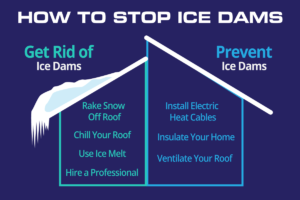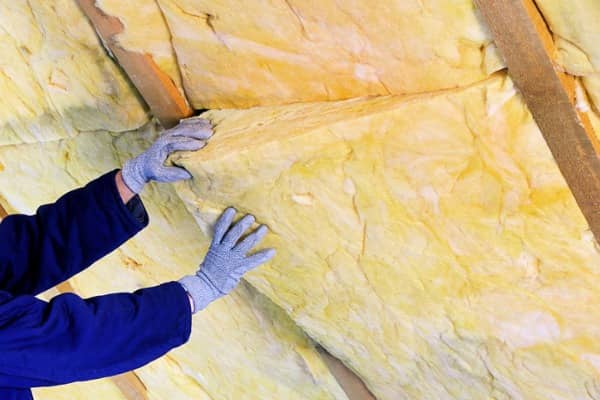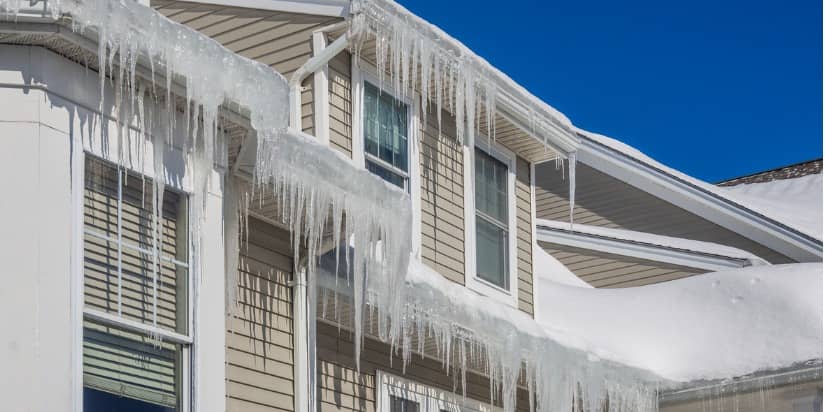Learn How to Stop Ice Dams to Avoid Damage to Your Roof, Gutters and Home!
Do you notice giant icicles hanging off gutters and roofs in the winter? Those icicles may look pretty, but they’re a source of severe winter damage to your roof.
What you’re seeing is called an ice dam. These icy buildups can harm the integrity of your roof and hurt the inside of your home.
As a homeowner, you want to protect your home and prevent any damage from happening. So, you’re probably wondering, how do you stop ice dams?
We can help! Keep reading to learn what an ice dam is, how they damage your home and how to stop ice dams.
What is an Ice Dam?
An ice dam is a barrier of ice that accumulates on your roof and gutters. Unfortunately, ice dams are very common throughout the Midwest region, especially for old, poorly insulated houses.
How Ice Dams Form
Ice dams form because of heat trapped under the roof, usually in the attic. If the temperature of your roof is 32 degrees Fahrenheit or higher, snow will melt on your roof.
Heat can get trapped in your attic in a couple of ways:
- Little to no insulation allows heat to escape in the attic.
- The attic lacks ventilation, keeping the heat trapped.
Once this melted snow gets to the colder edge of your roof, it refreezes. As water continues to melt and refreeze, it builds a dam.
Unfortunately, this buildup prevents melted water from draining off your roof. So, the water has no place to go except under your shingles and into your home.
Facts About Ice Dams
According to the IceDamGuys, one inch of snow can be enough for an ice dam to form. This is very rare, but under the right conditions, it could happen. You should be more concerned when you get six or more inches of snow. It also takes about 24 hours minimum for an ice dam to form.
Ice dams are a lot bigger than you might think. On average, they usually grow to 4-6 inches thick. However, they can get even thicker and weigh up to hundreds or even thousands of pounds! The bigger the icicle, the bigger chance it will cause you problems.
What Kinds of Damage Can Ice Dams Cause?
Ice dams can damage your home, both inside and out. And ice dam damage isn’t cheap to repair. So, it’s better to pay money to remove one than it is to repair accidents caused by one.
Let’s look at the ways ice dams can damage your home both outside and in:
Outdoor Damage
The weight of ice dams usually gets up to thousands of pounds. It’s hard to believe that it can weigh that much, but it’s true! Now imagine all that weight hanging off your gutters. The ice can pull your gutters right off your house!
Ice dams can also loosen and damage your shingles by lifting them and letting water get underneath. Continuous deterioration of your shingles can also cause more leaks and flooding inside of your home.
Indoor Damage
The most common type of indoor damage from ice dams is flooding. This happens when collected water can’t drain. Instead, it flows under your shingles and into your home.
Flooding can happen in your attic or throughout your house. Unfortunately, flooding can cause many things to go awry in your home, like:
- Drywall damage
- Mold and mildew growth
- Peeling paint
- Soaked carpets
- Warped floors
- Stained or sagging ceilings
It’s important to learn how to stop ice dams so that these things don’t happen in your home. Keep reading to learn how to get rid of them if you already have one and how to prevent them from happening.
 How to Get Rid of Ice Dams
How to Get Rid of Ice Dams
If you currently have an ice dam on your roof, it’s important to remove it as quickly as possible. However, do not get on your roof! It’s extremely dangerous, especially when there is ice involved.
Here are some tips for safely removing ice dams without having to get on top of your house:
Rake Snow Off Roof
One of the quickest ways to get rid of an ice dam is to remove snow from your roof. You’ll want to pull the snow off with a long roof rake while standing on the ground. If you already have an ice dam, removing the snow will prevent it from growing and help to make a path for melted water to drain.
Chill Your Roof
Another way to get rid of ice dams is to decrease the temperature of your roof. The best way to do this is to get up in your attic and angle a box fan towards the ceiling. Blowing the cold air in the attic will stop the snow from melting and stop the ice dam from growing.
Use Ice Melt
You can melt the ice dam more quickly with ice melt. The preferred option is to use calcium chloride or another kind of ice melt product. Whatever you do, do not use rock salt! This will do more damage to your roof than the ice.
Others might tell you to fill a pantyhose with ice melt and put it on your roof. We advise against this as it takes a lot of ice melt and the pantyhose don’t last. If you can safely reach the ice dam with a ladder, we recommend spreading calcium chloride over it instead.
Hire a Professional
The best way to remove an ice dam is to hire a professional. Companies that specialize in removing them use low-pressure steamers. This allows ice dams to melt safely without damaging your shingles.
However, be wary of hiring a contractor that uses a high-pressure washer. The high pressure will damage your shingles and cause more problems in the future.
How to Prevent Ice Dams
If you want to completely protect your home, the best way is to prepare your house to prevent ice dams from ever happening. This way, you won’t have to worry about damaged shingles, ripped-off gutters or flooding.
Here are some ice dam remedies you can put into place to keep them away:
Electric Heat Cables
Before the winter weather hits, you can put electric heat cables along your roof to make sure the melted snow stays melted. This will keep the edge of the roof where water refreezes warm so that an ice dam won’t grow. The best way to do this is by applying them in a zigzag formation along the edge of your roof.
Insulate Your Home
One of the best and most cost-effective ice dam solutions is to properly insulate your home. This will keep the heat where it belongs: in your living spaces.
Fortunately, there are plenty of ways you can go about insulating your home:
- Apply insulation in your ceiling, below the attic.
- Insulate attic access door.
- Caulk and seal windows and doors to keep heat in.
- Block any heat sources that go into your attic.
- Seal off heater vents with magnetic covers.
The exact amount of insulation you will need will depend on the size and shape of your home. However, a good rule of thumb is to use insulation with a rating of R-40 or higher in your attic. This insulation will be 11 or more inches thick.
Insulating your home will ensure heat doesn’t rise and get trapped in the attic, causing your roof’s temperature to rise. Not only will this step help prevent ice dams, but you’ll also save money by keeping the heat in your home.

One way you can stop ice dams is by applying insulation inside your home.
Ventilate Your Roof
After insulating your home, the next best step is to ventilate your attic and roof. Adding ventilation keeps colder air circulating throughout your attic, preventing the roof from getting warm and melting snow.
The best way to do this is by installing a ridge vent and soffit vents that will provide airflow through the edges and top of your roof. It’s best to have at least one vent per every 150 square feet. If you have a vapor barrier, you’ll want to have one vent per every 300 square feet.
Installing a ridge vent and soffit vents can be tricky. Therefore, this step is probably best done by a professional contractor, like Renowned Building Solutions.
Need More Help?
Now you know how to stop ice dams and keep your house safe. But were your roof or gutters recently damaged by an ice dam? Or do you need more assistance making sure your roof is ready for winter? We can help!
We at Renowned Building Solutions provide quality services throughout Northern Illinois and Southern Wisconsin, including residential roof repair and gutter replacement. Please contact us today to get a quote on your home project.



